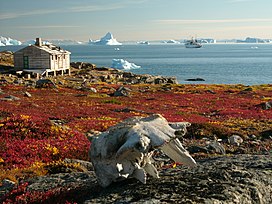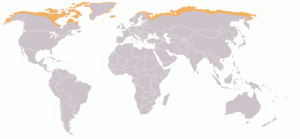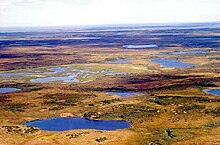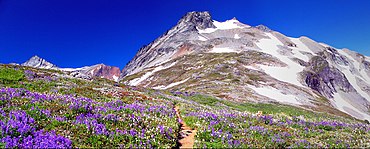| Tundra | |
|---|---|
 Tundra in Greenland | |
 Map showing Arctic tundra | |
| Geography | |
| Area | 11,563,300 km2 (4,464,600 sq mi) |
| Climate type | ET |
In physical geography, tundra (/ˈtʌndrə, ˈtʊn-/) is a type of biome where tree growth is hindered by frigid temperatures and short growing seasons. The term tundra comes through Russian тундра (tundra) from the Kildin Sámi word тӯндар (tūndâr) meaning "uplands", "treeless mountain tract". There are three regions and associated types of tundra: Arctic tundra, alpine tundra, and Antarctic tundra.
Tundra vegetation is composed of dwarf shrubs, sedges, grasses, mosses, and lichens. Scattered trees grow in some tundra regions. The ecotone (or ecological boundary region) between the tundra and the forest is known as the tree line or timberline. The tundra soil is rich in nitrogen and phosphorus. The soil also contains large amounts of biomass and decomposed biomass that has been stored as methane and carbon dioxide in the permafrost, making the tundra soil a carbon sink. As global warming heats the ecosystem and causes soil thawing, the permafrost carbon cycle accelerates and releases much of these soil-contained greenhouse gases into the atmosphere, creating a feedback cycle that increases climate change.
Arctic
Arctic tundra occurs in the far Northern Hemisphere, north of the taiga belt. The word "tundra" usually refers only to the areas where the subsoil is permafrost, or permanently frozen soil. (It may also refer to the treeless plain in general so that northern Sápmi would be included.) Permafrost tundra includes vast areas of northern Russia and Canada. The polar tundra is home to several peoples who are mostly nomadic reindeer herders, such as the Nganasan and Nenets in the permafrost area (and the Sami in Sápmi).
Arctic tundra contains areas of stark landscape and is frozen for much of the year. The soil there is frozen from 25 to 90 cm (10 to 35 in) down, making it impossible for trees to grow. Instead, bare and sometimes rocky land can only support certain kinds of Arctic vegetation, low-growing plants such as moss, heath (Ericaceae varieties such as crowberry and black bearberry), and lichen.
There are two main seasons, winter and summer, in the polar tundra areas. During the winter it is very cold, dark, and windy with the average temperature around −28 °C (−18 °F), sometimes dipping as low as −50 °C (−58 °F). However, extreme cold temperatures on the tundra do not drop as low as those experienced in taiga areas further south (for example, Russia's and Canada's lowest temperatures were recorded in locations south of the tree line). During the summer, temperatures rise somewhat, and the top layer of seasonally-frozen soil melts, leaving the ground very soggy. The tundra is covered in marshes, lakes, bogs, and streams during the warm months. Generally daytime temperatures during the summer rise to about 12 °C (54 °F) but can often drop to 3 °C (37 °F) or even below freezing. Arctic tundras are sometimes the subject of habitat conservation programs. In Canada and Russia, many of these areas are protected through a national Biodiversity Action Plan.
Tundra tends to be windy, with winds often blowing upwards of 50–100 km/h (30–60 mph). However, it is desert-like, with only about 150–250 mm (6–10 in) of precipitation falling per year (the summer is typically the season of maximum precipitation). Although precipitation is light, evaporation is also relatively minimal. During the summer, the permafrost thaws just enough to let plants grow and reproduce, but because the ground below this is frozen, the water cannot sink any lower, so the water forms the lakes and marshes found during the summer months. There is a natural pattern of accumulation of fuel and wildfire which varies depending on the nature of vegetation and terrain. Research in Alaska has shown fire-event return intervals (FRIs) that typically vary from 150 to 200 years, with dryer lowland areas burning more frequently than wetter highland areas.
The biodiversity of tundra is low: 1,700 species of vascular plants and only 48 species of land mammals can be found, although millions of birds migrate there each year for the marshes. There are also a few fish species. There are few species with large populations. Notable plants in the Arctic tundra include blueberry (Vaccinium uliginosum), crowberry (Empetrum nigrum), reindeer lichen (Cladonia rangiferina), lingonberry (Vaccinium vitis-idaea), and Labrador tea (Rhododendron groenlandicum). Notable animals include reindeer (caribou), musk ox, Arctic hare, Arctic fox, snowy owl, ptarmigan, northern red-backed voles, lemmings, the mosquito, and even polar bears near the ocean. Tundra is largely devoid of poikilotherms such as frogs or lizards.
Due to the harsh climate of Arctic tundra, regions of this kind have seen little human activity, even though they are sometimes rich in natural resources such as petroleum, natural gas, and uranium. In recent times this has begun to change in Alaska, Russia, and some other parts of the world: for example, the Yamalo-Nenets Autonomous Okrug produces 90% of Russia's natural gas.
Relationship to global warming
A severe threat to tundra is global warming, which causes permafrost to thaw. The thawing of the permafrost in a given area on human time scales (decades or centuries) could radically change which species can survive there. It also represents a significant risk to infrastructure built on top of permafrost, such as roads and pipelines.
In locations where dead vegetation and peat have accumulated, there is a risk of wildfire, such as the 1,039 km2 (401 sq mi) of tundra which burned in 2007 on the north slope of the Brooks Range in Alaska. Such events may both result from and contribute to global warming.
Greenhouse gas emissions
Carbon emissions from permafrost thaw contribute to the same warming which facilitates the thaw, making it a positive climate change feedback. The warming also intensifies Arctic water cycle, and the increased amounts of warmer rain are another factor which increases permafrost thaw depths. The amount of carbon that will be released from warming conditions depends on depth of thaw, carbon content within the thawed soil, physical changes to the environment and microbial and vegetation activity in the soil. Microbial respiration is the primary process through which old permafrost carbon is re-activated and enters the atmosphere. The rate of microbial decomposition within organic soils, including thawed permafrost, depends on environmental controls, such as soil temperature, moisture availability, nutrient availability, and oxygen availability. In particular, sufficient concentrations of iron oxides in some permafrost soils can inhibit microbial respiration and prevent carbon mobilization: however, this protection only lasts until carbon is separated from the iron oxides by Fe-reducing bacteria, which is only a matter of time under the typical conditions. Depending on the soil type, Iron(III) oxide can boost oxidation of methane to carbon dioxide in the soil, but it can also amplify methane production by acetotrophs: these soil processes are not yet fully understood.
Altogether, the likelihood of the entire carbon pool mobilizing and entering the atmosphere is low despite the large volumes stored in the soil. Although temperatures will increase, this does not imply complete loss of permafrost and mobilization of the entire carbon pool. Much of the ground underlain by permafrost will remain frozen even if warming temperatures increase the thaw depth or increase thermokarsting and permafrost degradation. Moreover, other elements such as iron and aluminum can adsorb some of the mobilized soil carbon before it reaches the atmosphere, and they are particularly prominent in the mineral sand layers which often overlay permafrost. On the other hand, once the permafrost area thaws, it will not go back to being permafrost for centuries even if the temperature increase reversed, making it one of the best-known examples of tipping points in the climate system.In 2011, preliminary computer analyses suggested that permafrost emissions could be equivalent to around 15% of anthropogenic emissions.
A 2018 perspectives article discussing tipping points in the climate system activated around 2 degrees Celsius of global warming suggested that at this threshold, permafrost thaw would add a further 0.09 °C to global temperatures by 2100, with a range between 0.04 °C and 0.16 °C In 2021, another study estimated that in a future where zero emissions were reached following a emission of a further 1000 Pg C into the atmosphere (a scenario where temperatures ordinarily stay stable after the last emission, or start to decline slowly) permafrost carbon would add 0.06 °C (with a range between 0.02 °C and 0.14 °C) 50 years after the last anthropogenic emission, 0.09 °C (with a range between 0.04 °C to 0.21 °C) 100 years later and 0.27 °C (ranging between 0.12 to 0.49 °C) 500 years later. However, neither study was able to take abrupt thaw into account.
In 2020, a study of the northern permafrost peatlands (a smaller subset of the entire permafrost area, covering 3.7 million km2 out of the estimated 18 million km2) would amount to ∼1% of anthropogenic radiative forcing by 2100, and that this proportion remains the same in all warming scenarios considered, from 1.5 °C to 6 °C. It had further suggested that after 200 more years, those peatlands would have absorbed more carbon than what they had emitted into the atmosphere.
The IPCC Sixth Assessment Report estimates that carbon dioxide and methane released from permafrost could amount to the equivalent of 14–175 billion tonnes of carbon dioxide per 1 ºC of warming. For comparison, by 2019 the anthropogenic emission of all carbon dioxide into the atmosphere stood around 40 billion tonnes.
A 2021 assessment of the economic impact of climate tipping points estimated that permafrost carbon emissions would increase the social cost of carbon by about 8.4% However, the methods of that assessment have attracted controversy: when researchers like Steve Keen and Timothy Lenton had accused it of underestimating the overall impact of tipping points and of higher levels of warming in general, the authors have conceded some of their points.
In 2021, a group of prominent permafrost researchers like Merritt Turetsky had presented their collective estimate of permafrost emissions, including the abrupt thaw processes, as part of an effort to advocate for a 50% reduction in anthropogenic emissions by 2030 as a necessary milestone to help reach net zero by 2050. Their figures for combined permafrost emissions by 2100 amounted to 150–200 billion tonnes of carbon dioxide equivalent under 1.5 degrees of warming, 220–300 billion tonnes under 2 degrees and 400–500 billion tonnes if the warming was allowed to exceed 4 degrees. They compared those figures to the extrapolated present-day emissions of Canada, the European Union and the United States or China, respectively. The 400–500 billion tonnes figure would also be equivalent to the today's remaining budget for staying within a 1.5 degrees target. One of the scientists involved in that effort, Susan M. Natali of Woods Hole Research Centre, had also led the publication of a complementary estimate in a PNAS paper that year, which suggested that when the amplification of permafrost emissions by abrupt thaw and wildfires is combined with the foreseeable range of near-future anthropogenic emissions, avoiding the exceedance (or "overshoot") of 1.5 degrees warming is already implausible, and the efforts to attain it may have to rely on negative emissions to force the temperature back down.
An updated 2022 assessment of climate tipping points concluded that abrupt permafrost thaw would add 50% to gradual thaw rates, and would add 14 billion tons of carbon dioxide equivalent emissions by 2100 and 35 by 2300 per every degree of warming. This would have a warming impact of 0.04 °C per every full degree of warming by 2100, and 0.11 °C per every full degree of warming by 2300. It also suggested that at between 3 and 6 degrees of warming (with the most likely figure around 4 degrees) a large-scale collapse of permafrost areas could become irreversible, adding between 175 and 350 billion tons of CO2 equivalent emissions, or 0.2–0.4 degrees, over about 50 years (with a range between 10 and 300 years).Antarctic
Antarctic tundra occurs on Antarctica and on several Antarctic and subantarctic islands, including South Georgia and the South Sandwich Islands and the Kerguelen Islands. Most of Antarctica is too cold and dry to support vegetation, and most of the continent is covered by ice fields. However, some portions of the continent, particularly the Antarctic Peninsula, have areas of rocky soil that support plant life. The flora presently consists of around 300–400 species of lichens, 100 mosses, 25 liverworts, and around 700 terrestrial and aquatic algae species, which live on the areas of exposed rock and soil around the shore of the continent. Antarctica's two flowering plant species, the Antarctic hair grass (Deschampsia antarctica) and Antarctic pearlwort (Colobanthus quitensis), are found on the northern and western parts of the Antarctic Peninsula. In contrast with the Arctic tundra, the Antarctic tundra lacks a large mammal fauna, mostly due to its physical isolation from the other continents. Sea mammals and sea birds, including seals and penguins, inhabit areas near the shore, and some small mammals, like rabbits and cats, have been introduced by humans to some of the subantarctic islands. The Antipodes Subantarctic Islands tundra ecoregion includes the Bounty Islands, Auckland Islands, Antipodes Islands, the Campbell Island group, and Macquarie Island. Species endemic to this ecoregion include Corybas dienemus and Corybas sulcatus, the only subantarctic orchids; the royal penguin; and the Antipodean albatross.
There is some ambiguity on whether Magellanic moorland, on the west coast of Patagonia, should be considered tundra or not. Phytogeographer Edmundo Pisano called it tundra (Spanish: tundra Magallánica) since he considered the low temperatures key to restrict plant growth.
The flora and fauna of Antarctica and the Antarctic Islands (south of 60° south latitude) are protected by the Antarctic Treaty.
Alpine
Alpine tundra does not contain trees because the climate and soils at high altitude block tree growth. The cold climate of the alpine tundra is caused by the low air temperatures, and is similar to polar climate. Alpine tundra is generally better drained than arctic soils. Alpine tundra transitions to subalpine forests below the tree line; stunted forests occurring at the forest-tundra ecotone (the treeline) are known as Krummholz.
Alpine tundra occurs in mountains worldwide. The flora of the alpine tundra is characterized by plants that grow close to the ground, including perennial grasses, sedges, forbs, cushion plants, mosses, and lichens. The flora is adapted to the harsh conditions of the alpine environment, which include low temperatures, dryness, ultraviolet radiation, and a short growing season.
Climatic classification
Tundra climates ordinarily fit the Köppen climate classification ET, signifying a local climate in which at least one month has an average temperature high enough to melt snow (0 °C (32 °F)), but no month with an average temperature in excess of 10 °C (50 °F). The cold limit generally meets the EF climates of permanent ice and snows; the warm-summer limit generally corresponds with the poleward or altitudinal limit of trees, where they grade into the subarctic climates designated Dfd, Dwd and Dsd (extreme winters as in parts of Siberia), Dfc typical in Alaska, Canada, mountain areas of Scandinavia, European Russia, and Western Siberia (cold winters with months of freezing).
Despite the potential diversity of climates in the ET category involving precipitation, extreme temperatures, and relative wet and dry seasons, this category is rarely subdivided. Rainfall and snowfall are generally slight due to the low vapor pressure of water in the chilly atmosphere, but as a rule potential evapotranspiration is extremely low, allowing soggy terrain of swamps and bogs even in places that get precipitation typical of deserts of lower and middle latitudes. The amount of native tundra biomass depends more on the local temperature than the amount of precipitation.
Places featuring a tundra climate
- Alpine tundra
- Gavia Pass, Italy
- Mount Fuji, Japan
- Cerro de Pasco, Peru
- Apartaderos, Venezuela
- Puno, Peru
- Kasprowy Wierch, Poland
- High Tatras, Slovakia
- Murghob, Tajikistan
- Mount Wellington, Australia
- Cairn Gorm, United Kingdom
- Putre, Chile
- Coranzuli, Argentina
- Yu Shan, Taiwan
- Juf, Switzerland
- Finse, Norway





